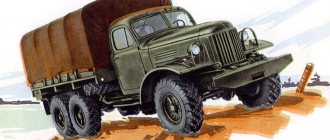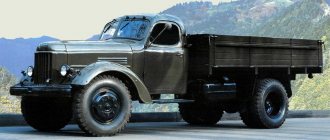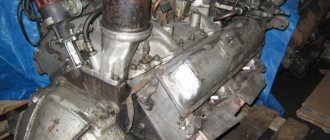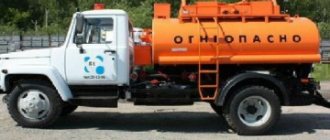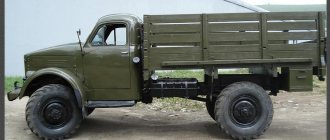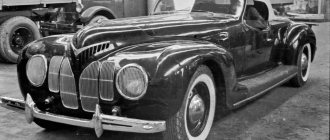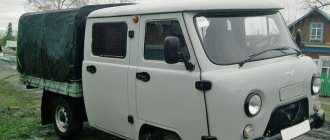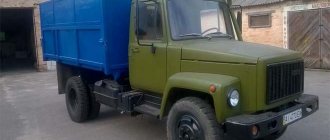It turns out that in Kutaisi, in Soviet times, they not only made high-quality shoes underground. The Kutaisi Automobile Plant produced KAZ 4540 trucks quite legally. About 20 thousand vehicles rolled off the assembly line per year. Experienced drivers remember this model well, designed for transporting various cargoes. Basically, a vehicle with a trailer transported grain weighing up to 11 tons from the field to the current and elevator.
She was not afraid of field roads. The truck frame was actively used to install military equipment of the Soviet Army.
MAZ 500: technical specifications, photos, videos, cabin, clutch, weight and photos, interior.
KamAZ agricultural worker 55102 and its technical characteristics are described in this article.
MAZ 5516: description and technical characteristics.
The legend of the Georgian automobile industry
The Kutaisi Automobile Plant named after Sergo Ordzhonikidze dates back to April 1945, when the construction of this large enterprise began. The first car was produced here in August 1951. it became the ZIS-150 truck. Subsequently, for several years the plant produced, in modern terminology, “screwdriver assembly” of ZIS-150 vehicles and their modifications. All components for this were supplied from the Moscow Plant named after Stalin (since June 1956 - named after Likhachev).
In the mid-50s, KAZ was focused on producing special vehicles on the ZIS chassis, designed for transporting bulk and semi-liquid building materials (concrete mortar, cement, building mixtures). The company created its own design bureau, which began developing its own models. The design bureau was tasked with developing promising models of universal dump trucks and truck tractors that would be convenient to use both in industry and agriculture.
At the instigation of its design bureau, the Kutaisi plant was the first in the Soviet Union in 1961 to master the serial production of trucks with a cabover design (the first cabover MAZ-500 already existed, but was launched into “series” only in 1965). They were the KAZ-605 truck with a carrying capacity of 5 tons and the KAZ-606 truck tractor for working with a 10-ton semi-trailer.
The cabover design in those years was considered a newfangled and progressive solution: a lot was said about maximizing the usable area of the vehicle, reducing its length and wheelbase, improving visibility from the driver’s seat and the maneuverability of trucks. We must pay tribute to the enthusiasm of the plant’s specialists: the new cars were developed, tested and put into production in the shortest possible time, by the standards of the automotive industry. True, only the layout was new in them: the engine and transmission were used from the serial ZIL-164 truck.
Our own models are in honor of the glorious ancient kingdom that existed in these places back in ancient times. This romantic name remained with the Kutaisi trucks even after the inscription “Colchis” in 1975, in the new KAZ-608 model, disappeared from their cabs and was replaced simply by “KAZ”. KAZ-608 and its modifications became the most popular model in the history of the enterprise. And now, when they talk about “Colchis”, they usually mean this particular machine, replicated in hundreds of thousands of copies.
The romantic history of the Georgian automobile industry, unfortunately, is overshadowed by sharply negative reviews about the quality of KAZ cars. Trucks from Kutaisi in absolutely all regions of the big country have gained notoriety among drivers, and their reputation has developed, as they say, “below the plinth”. In motor transport enterprises, drivers tried by hook or by crook to avoid working on unreliable Colchis and KAZ vehicles. As a result, guilty drivers were usually “put on these cars” as a form of punishment.
There were no hunters to go to the factory for a new truck. Typically, drivers from the “old guard” really liked to go on such business trips: they could make good money, and simply “change the scenery while traveling.” But not in Kutaisi! Because such a trip could become too troublesome: the truck could often not even make its first route from the plant to a transport enterprise in another region of the USSR without breakdowns.
Everything suggests that the Kutaisi plant had insufficient quality control and low production standards, as a result of which the assembly was simply disgusting. In addition, for a truck tractor their engine was rather weak, and at the same time it consumed a lot of fuel even by Soviet standards: 50 liters per 100 km or even more. Very rare Kutaisi trucks fulfilled their required working life. But they took a prominent place in folklore (the proverbs “A chicken is not a bird, Colchis is not a car” and others, some of which are not very convenient to repeat in polite society).
But how then, one might ask, did the plant produce tens of thousands of cars a year? Who bought them? It's simple: these are the “grimaces” of the Soviet planned economy and the administrative-command system. After all, the cars were not purchased by entrepreneurs for “their own hard-earned” money, but according to orders and government orders. In addition, there were, in fact, no alternatives in this class at that time. A truck tractor of this class was produced only by ZIL, and even then in very limited quantities. MAZs and KamAZs are vehicles of a completely different class and from a completely different story. Therefore, even the unreliable Colchis-KAZ vehicles found their own “niche” in the national economy and their own scope of work.
Early 80s. Pre-production KAZ-4540 being tested.
So the enterprise with a staff of 18 thousand people worked in Kutaisi until the collapse of the Soviet Union. In the 90s, the automobile plant fell into disrepair: Russia stopped purchasing Kutaisi trucks; exporting them, even to backward developing countries, was not possible due to low quality and competitiveness, and for the internal needs of Georgia, a maximum of two to three dozen trucks of this class were required in year.
Today, the buildings of the Kutaisi Automobile Plant and the avenues between the workshops are dilapidated and overgrown with wild trees and bushes, machine tools and other property have long been looted and sold for scrap. Life glimmers only in the administrative building, which is rented out to various organizations.
"Colchis"
This name was given to the model range of tractors produced by the Kutaisi plant. The first truck left in August 1951. Most of the components were brought from the Stalin plant. Thanks to the components of the Moscow enterprise, dump trucks, small truck tractors, as well as cargo vehicles under the Kolkhida brand were assembled. Photos of the new copy were not similar to any existing at that time.
"4540" is a model created to meet the needs of agriculture. Production continued from 1985 to 1998. During this period, several different modifications of the Colchis truck were created. A distinctive feature of the KAZ-4540 was its bright orange cabin with very large windshields.
Scope of application of KAZ-4540
The development and preparation for serial production of the KAZ-4540 was carried out in close cooperation with specialists from the Central Scientific Research Automobile and Motor Vehicle Institute (NAMI). As noted, this model was not intended to simply be a “truck that gets something from point A to point B”, but rather a universal carrier for the agricultural industry.
Which will be able to drive without problems both along field roads and through the fields themselves to collect the harvest. Will be able to tow a trailer and carry a significant amount of cargo at one time. But at the same time, with its high off-road capability, it will show decent driving performance when driving on general roads.
At the same time, it was planned to make the KAZ-4540 not just a dump truck, but an “agricultural truck,” that is, with an unloading function on three sides. The engine for the KAZ-4540 was originally intended to be diesel. Already in the early 80s, it became obvious that the era of gasoline trucks was close to its end. After all, when replacing a gasoline engine with a diesel engine of the same power, savings in fuel costs of 25% are achieved. And in difficult operating conditions – even 45-50%.”
At the testing stage, in 1982, the truck was called NAMI-0215, and it entered mass production in the last pre-perestroika year - 1984, under the name KAZ-4540. The new “agricultural trucks” had a very cheerful appearance, bright yellow and orange coloring. To begin with, in 1984, 500 of these trucks, completely different from the previous Colchis trucks, were built. And in the future it was planned to reach a production volume of 20 thousand KAZ-4540 for Soviet agriculture annually.
In the magazine “Behind the Wheel” in 1983, it was noted that the KAZ-4340 is much easier to drive than any of those currently used in the countryside, thanks to the power steering and effective synchronizers in the transmission. That the driver's workplace is designed in accordance with modern ergonomic requirements. "But that is not all. Drivers driving all-wheel drive vehicles sometimes complain about accelerated wear of the constant velocity joint. In the interests of increasing the durability of the KAZ-4540, it was made of an increased size and a different design: the hinge is not a ball joint, but a disk one, so it is simpler, more technologically advanced and more reliable.”
Power component
The vehicle was equipped with a YaMZ-KAZ-642 diesel engine. The KAZ-4540 engine was installed behind the wheelbase and was paired with an eight-speed gearshift device (4 available gears and an additional divider).
The power plant was located directly above the front axle, and all control elements were moved as far forward as possible. The driver's seat was above the engine. The decision to create such an arrangement was caused by the need to increase the usable area on which the transported materials were located. By increasing the departure angle, the cross-country ability was increased. This scheme ensured even distribution of the load on both axles. The front carries 6.12 tonnes of weight and the rear 6.14 tonnes.
Uniform loading allowed the use of single wheels with wide tires, and also greatly simplified the pressure control system in the air chambers.
Many innovations were introduced during the creation of the KAZ-4540. One of these was a disk CV joint, which was more reliable than its spherical counterpart. The maximum speed was 80 km/h, but the load capacity was only 6 tons.
Design features, main characteristics
The first production cars had a round configuration of the front wheel wings and a cylindrical fuel tank. Subsequently, the shape of the wings and tank was simplified. The KAZ-4340 was equipped with a V-shaped six-cylinder diesel engine YaMZ-642 with a power of 155 hp, located outside the wheelbase and working in conjunction with an eight-speed gearbox. Moreover, the gearbox is installed in the middle of the car, under its body. This gave an almost ideal weight distribution of the total weight of the car. The all-wheel drive in the KAZ-4340 is permanent, non-switchable, and the transfer case is equipped with a lockable center differential.
At a maximum speed of 80 km/h, the machine's load capacity is 6 tons. The agricultural road train consists of a two-axle all-wheel drive truck KAZ-4540 and a two-axle dump trailer GKB-8535. The load capacity of the road train is 11.5 tons, and its total weight is 21 tons. The trailer this machine worked with had almost the same body volume as the dump truck itself, a hydraulic lift, and a side unloading function.
To be precise, according to the developers, the KAZ-4540 can tow a trailer with a total weight of 9 tons on unpaved roads, and 12 tons on paved roads. The cargo platform of this truck is all-metal, and in order to more fully utilize the carrying capacity when transporting bulk cargo with a relatively small mass (hay in bales and rolls, for example), the installation of extension sides was provided.
The cargo platform of the KAZ-4540 dump truck and the standard two-axle trailer for it were developed by the designers of the Balashovsky State Design Bureau for tractor and automobile trailers. The impressive capacity of the bodies (13.76 cubic meters) with extension sides made it possible to achieve high practical efficiency of the vehicle.
Another feature of the design was the uniform axle load of 6.1 tons on each axle, as well as the use of wheels on wide-profile single-row tires (rear and front - single-ply), size 370/80-508. For this truck, by the way, special tires were developed that provide selected ground pressure, without a centralized air pressure control system.
The car had drive axles of an advanced original design and a stamped riveted frame, consisting of two spars of variable cross-section, as well as front and rear suspension on semi-elliptical springs.
The only modernization of the truck was the KAZ-4540-01 version, which appeared by the end of the 80s, which, unlike the regular KAZ-4540, received a hydraulic side locking system. An all-wheel drive vehicle for applying fertilizers was also developed and manufactured on the KAZ-4540 chassis. It was also planned to use this vehicle as a refrigerated van, flatbed truck and special firefighting vehicle. But these developments were not implemented.
Purpose
The KAZ-4540 freight transport, which differed from all other models in having two drive axles, was often used in conjunction with a GKB-8535 trailer. This bundle represented a kind of road train used for transporting agricultural products.
The KAZ-4540 dump truck is a universal machine with the ability to unload on three sides. Depending on the specific materials or terrain, one specific method was used. The truck was equipped with all-wheel drive with an additional differential lock on the rear axle.
The technological design made it possible to use the machine in tandem with combine harvesters for harvesting grain and cotton crops. “Kolkhida” is a vehicle with sufficient cross-country ability required for equipment used in agriculture and a productivity of 11 tons.
In 1990, the designers prepared documentation that would allow the vehicle to be equipped with a refrigerator, used together with a cargo platform, and also to create a vehicle for firefighters. Unfortunately, the developments were not further developed and remained only on paper. “Kolkhida”, the photo of which is presented below, is the most popular copy at the time of the car’s creation.
Engine and transmission KAZ-4540
The YaMZ-642 diesel engine was developed at the Yaroslavl Motor Plant on the basis of the main KamAZ power unit - KamAZ-740. Only two of the eight cylinders were removed, making a six-cylinder engine. Accordingly, all valve timing has been recalculated, and the high-pressure fuel pump (HPF) is also designed for six rather than eight cylinders.
At YaMZ, these engines were just developed, and their production was completely transferred to Kutaisi, where they disappeared into oblivion along with the Georgian automobile industry.
- Engine power YaMZ-642 – 160 hp. (118 kW).
- Rated rotation speed – 2600 rpm.
- Working volume – 8.14 l.
- Cylinder diameter – 120 mm, piston stroke – 120 mm.
- Compression ratio – 17.
The gearbox of the KAZ-4540 is also original. It is not aggregated with the engine: the engine is located in the front of the car, and the gearbox is in the middle of the truck, and between them is an intermediate driveshaft. This is a bold and quite successful decision: it is easy to mount and dismantle the box, and it does not have to be unscrewed from the engine. The KAZ-4540 gearbox is mechanical, 8-speed, interlocked with a single-speed transfer case.
Flaws
The low qualifications of the plant’s specialists did not allow the production of high-quality equipment to be established. The cars had the following disadvantages:
- the cabin lift mechanism failed;
- leaks of oil and working fluids at the junctions of engine and transmission components and mechanisms;
- the valve and pneumatic chamber on the clutch pneumatic drive were unreliable;
- the brake pads were clogged with dirt and did not work;
- The injection pump did not produce the necessary parameters;
- The rivets securing the front spring to the frame were cut off.
The same weight distribution along the axles, along with the advantages in cross-country ability, unloaded the rear axle, which, if driven carelessly, could lead to the vehicle tipping over.
The total shortage of factory-produced spare parts led to the installation of components from other cars - unique car designers took to the roads.
Refusal of professional drivers to work in a Kutaisi car.
According to some reports, several KAZ-4540 vehicles are assembled in Kutaisi for the needs of the Georgian Republic every year; there is information on the Internet about machines still operating in rural regions of Russia and Ukraine.
According to auto experts, the appearance of an original rural truck within the framework of the State Food Program would certainly be successful if the leadership of the Union automobile industry took a more responsible approach to choosing a manufacturer.
The following video review discusses in more detail the technical characteristics of the KAZ-4540:
Suspension and chassis, brakes
The front suspension of the latest Georgian truck is on single longitudinal semi-elliptic springs with telescopic hydraulic shock absorbers, the rear suspension is on double longitudinal semi-elliptic springs. A strong chassis allows the vehicle to move not only off-road, but also directly across the fields.
The high-torque transmission allows you to accompany the agricultural combine at a minimum speed of 2 km/h. The brake system is pneumatic, all brake mechanisms are of the drum type, with automatic adjustment of the gaps between the brake pads and the drum.
Why do we need a special car in the countryside?
And when all sectors of the economy were saturated with motor transport for all main tasks. Then in the 70s they finally remembered the problems of the village. In the part about cross-country ability when working in the fields in any weather. A very important factor here is the speed of field work.
For tractors this means plowing, harrowing, and sowing. For combines - harvesting speed. For cars - the speed of delivery of goods to and from the field. Given the little predictable weather changes. It may prevent the fields from being sown on time. That's how you harvest.
Prolonged rains can completely wash out roads and make fields inaccessible for work. Early frosts can destroy an already ripe crop. In addition, vast amounts of space. Lots of fields themselves and limited number of people and technology. They demand that each of them be removed as quickly as possible. In order to have time to collect the entire harvest and not leave it in the field to the mercy of the weather.
Therefore, the speed of delivery to and from the field. The speed of changing vehicles under harvesting equipment is a very important condition for harvesting fields. Hence, the vehicle movement time should be minimal. This requires cross-country ability in any weather and maintaining average transport speed. Again, so that equipment and people do not stand idle in bottlenecks. At loading, at unloading, in the bogged down mud of the roads.
The vast expanses of Russia and the climate simply physically do not allow roads to be laid everywhere. Therefore, simple methods of maintaining country roads are often used.
They are leveled with bulldozers, the resulting holes are filled in and compacted with the wheels of equipment. This allows you to have good wheel grip on the packed country road even in rainy weather.
Technical specifications in numbers
- Length – 6.575 meters; width – 2.5 m; height – 2,830 meters.
- Dimensions of the cargo platform: length – 4.4 m; width – 2.32 m; the height of the sides without extensions is 68 cm.
- The distance between the centers of the wheels of the front and rear axles is 2.02 m.
- The curb weight of the car is 3.61 tons.
- Load capacity – 6 tons.
- The weight of the towed trailer is 9 tons on the ground, 11.5 tons on paved roads.
- Fuel tank capacity – 250 liters.
- Diesel fuel consumption is 25...30 liters per 100 km.
What was in production before this
In particular, GAZons previously used in the USSR in rural areas (GAZ 52, 53). ZIL 130, very rarely KAMAZ. The latter are more likely to be used for transporting crops to the city along asphalt roads. And also for the supply of equipment, spare parts, fertilizers, building materials and other things to rural areas.
For example, even a KAMAZ agricultural truck with unloading on 3 sides was rare and expensive. Those. all of the above cars were without front-wheel drive. And, as a rule, on road tires. No design features. And without special devices. For off-road and field work.
MAZs and KRAZs were an unattainable luxury. As a rule, cranes were installed on them for unloading and loading something from railway platforms. They were used in the construction of infrastructure.
In the USSR, railway transport was very actively used. To supply the most remote corners and regional centers. Which greatly relieved the roads from freight traffic.
Almost 80% of supply cargo was transported by rail. For rural areas and back harvest. The same vehicles were generally used very wisely. As a rule, only on local regional roads - for transportation from the field to primary processing. For grain sorting, for a dairy plant, a canning plant, a meat processing plant, for an elevator. For ferrous metal - for scrap metal, etc.
And already from these factories, almost everywhere there were access railway tracks from regional marshalling stations. They loaded them into wagons. Refrigerators, grain carriers, open platforms, high-sided and covered wagons. They supplied the countryside in the same way, transporting fuel to oil depots. Coal for boiler houses for unloading to one place in the area.
And then they were taken to farms. Incl. equipment for enterprises, state farms and collective farms. It was a very well-thought-out and well-performed transport system of the country. With minimal use of roads and trucks.
Because one locomotive with one engine pulls up to 50 cars. In each of which there may be cargo up to 40 tons. And how many separate vehicles are needed, their maintenance and smoky engines, plus drivers to transport similar cargo... Many times more.
What about URALs?
The same URALs were mostly gasoline. Diesel engines will appear only in the 80s. Gasoline cars were very voracious in terms of fuel consumption. Accordingly, the harvest became “golden” at the price of fuel costs.
Despite the fact that all of the above cars had all-wheel drive modifications. And they very rarely ended up in agriculture. The key role for rural food producers has always been the price: for the car itself and the costs of its operation.
Because this is a key indicator. Even in the USSR, with its low state prices and prices for everything, it played a very important role. In order to have a low cost of primary products supplied to raw material processing enterprises. Milk, beet roots, grains, fruits and vegetables. And, accordingly, for food products for final consumption. Dairy products of all types, sugar, bread and cereals, juices, vegetables for cooking.
Cabin KAZ-4540
The three-seater all-metal cabin of the KAZ-4540 is located in front of the front axle. To service the engine, it tilts forward on hinges, with a hydraulic lift. The KAZ-4540 cabin is equipped with a heater, and there is space for a radio, ultra-short wave radio station, and air conditioning.
In general, the KAZ-4540 cabin is quite wide and spacious. There is no sleeping place in it - this is a “farmer”, not a “truck driver”.
Criteria for creating a special car
In particular, the cost of food for end consumers in canteens depended on this. In kindergartens, schools, summer camps, sanatoriums, holiday homes, tourist centers. As well as low-income groups of citizens (pensioners, disabled people, students) and so on.
That is why every director of a state farm or collective farm in the USSR. And even now the heads of agricultural production. They try in every possible way to keep costs at an acceptable minimum level. Otherwise, they will quickly compete on price with producers from neighboring countries.
Otherwise, after a series of bankruptcies, it is very difficult to resume production again. And this will first of all hit the residents of this area hard.
From an economic point of view: one villager gives work to at least five. This is a very important indicator in the country's economy!
- Civil service: bank, post office, administration, pension fund, firefighters, police, medicine, tax. Military registration and enlistment office, gas industry, schools, kindergartens, boarding schools, vocational schools, technical schools or colleges, branches of universities and the like.
- Builders of roads, buildings and structures, communications. Pipelines, water channels, underground and above-ground communication lines, and the like.
- Manufacturers of equipment (cars, tractors, machine tools, boilers, processing equipment, etc.
- Electricians (power lines, local distribution substations, building connections).
- Signalmen (television, telephone, telegraph, cellular communications, Internet).
- Commerce. Trade, warehouses, transportation, insurance companies, services. Photography, hairdressers, tailoring, repair and setup of computers, office equipment and household appliances and the like.
Often, if there are no key producers of agricultural or industrial products in the area. These are the main tax payers. The other above-mentioned areas of activity simply fall apart over time.
Reviews from professionals about KAZ-4540
For the 80-90s, the KAZ-4540 was a modern and promising truck, in some ways even ahead of its time, with an “eye on the future.” If the USSR had not been destroyed, this model would have found a place on the market, subject to appropriate improvements in the quality of its manufacturing and assembly: there was certainly a need for machines of this type on farms. But these prospects were not destined to develop.
As for the operating characteristics of the car, it is difficult to give it an adequate assessment. Since there are very few reliable reviews regarding the KAZ-4540 model, and most of them are based on negative stereotypes about previous cars of the Kutaisi plant.
It is unlikely, of course, that with the start of production of the new model, the company experienced noticeable progress in the quality of its products: after all, the truck was assembled at the same plant, and it was done by the same workers. But the design itself of the last of the “Colchis” was very advanced and progressive.
Indirect evidence of the traditional poor quality of the KAZ-4540 is also contained in the story of the head of the Auto-Retro club (Krasnoyarsk city) Alexander Knapnugel. The KAZ-4540 with an original trailer from the club’s collection was assembled and restored from three trucks of this brand, produced in the late 80s, in varying degrees of preservation. “They didn’t even have time to really work - they almost immediately stood up,” notes Alexander, “this is immediately visible from the body: after all, when they carry cargo in it, it is damaged, scratched, the metal bends, but here you can see that everything remains like new.” .
Restored KAZ-4540 from the Krasnoyarsk Auto-Retro club.
Naturally, with such quality of products, the plant could not experience problems with sales only under the conditions of the planning and distribution system. In addition, if the old Colchis still retained a fairly significant degree of compatibility of components and parts with ZILs, then the KAZ-4540 simply did not have spare parts, and getting them was a big problem.
Since this machine was produced for a relatively short time, and there were only a few of them made, there was no such thing as a large number of them being written off somewhere “under the fence,” and, accordingly, there was nowhere to screw together the necessary parts. And since the design is unusual, components and parts from other machines could not be adapted. For example, the same injection pump - only the original one is suitable, no other can be used.
Review of the basic model KAZ-606 "Kolkhida"
The viewing angles in the first “Colchis” were truly amazing
When the first Colchis was launched into mass production, the factory workers did not split hairs; only the layout was original in the new truck. The axles, engine, gearbox and many other elements were taken from the ZIL-164, which was tested in production.
However, even this was enough to attract the attention of both auto industry ministers and ordinary people. The cabin was located above the engine, which made it possible to make the layout cabover. This was the first case in the domestic automotive industry. And the contours of the all-metal cabin themselves were advanced at that time. It is worth remembering that the year was 1961; the country had not long ago replaced the box-shaped ZIS-5 on the wartime assembly line with more modern ZIS-150s, which with their long hoods and radiator grilles still resembled Lend-Lease Studebakers.
In the case of the KAZ-606, the driver received a spacious cabin with panoramic front and curved rear windows extending onto the sides. After the dark cabs of ZIS cars, the driver sat as if in an aquarium, and the visibility of the new truck was simply wonderful.
The designers also took care of comfort, because the car was originally planned to be used for long-distance transportation, this was facilitated by the design of the long-haul truck tractor itself. Behind the front seats there was a sleeping place - an innovation unheard of for ascetic Soviet trucks. Now two drivers could not only change positions on the road, but also stretch out on the back seat, which helped relieve fatigue. A fan was installed in the cabin for operation in hot regions, and fog lights were installed on the front end. By the way, the gearshift lever was to the right of the driver, but the handbrake handle was to the left.
Thus, advanced interior equipment solutions were at a high level. As for the power unit, the first copies were equipped with the well-known, but already outdated at that time, ZIS-120K engine with 6 cylinders arranged in a row with a volume of 5.5 liters. The carburetor “six” produced 90 horses at 2600 rpm, but this was clearly not enough for a loaded road train.
The appearance of the production model has also undergone some changes. Thus, the front round headlights were moved from the top of the front panel of the cab down to special recesses on the sides of the radiator grille, which made the “appearance” of the car more presentable.
Scarier than a tiger or a lynx...
Unfortunately, the disadvantages of Colchis were identified immediately after the start of operation. The car was clearly “raw” and required improvements. The old engine could not provide either high speed or normal cargo traction. The quality produced by Georgian car assemblers was low, much lower than at the parent Likhachev Automobile Plant. In addition, drivers complained about access to the engine: it was done through a special hatch between the seats. Losing its tightness, it began to leak gasoline fumes from the engine into the cabin, which negated all the advantages in comfort.
…a car from Kutaisi
Already in 1962, the KAZ-606 was modernized: an updated ZIS-120KYa engine was installed under the cabin, in which the compression ratio and crankshaft rotation speed were increased and a more successful carburetor was installed. This gave a power increase of 20 hp. With. and torque at 200 rpm. After this, the tractor could tow trailers up to 10.5 tons, but fuel consumption was terrifying: up to 50 liters per hundred kilometers, even with the lowest octane fuel.
Video: KAZ-606 “Colchis”
Price of a used KAZ-4540 truck
The KAZ-4540 all-wheel drive truck is a rarity in the 21st century. There are only a few announcements about its sale in all of vast Russia. For cars in working condition produced in 1989-1990 they ask for 200-250 thousand rubles. As a rule, these are poorly used (for example, as in one of the advertisements, they transported an apiary from place to place) specimens.
Interestingly, there are an order of magnitude more advertisements for the sale of used KAZ-4540s in Ukraine than in Russia. Years of production – from 1986 to 1991. The price range is from 50,000 to 130,000 hryvnia.
Advantages of the car
Drivers who witnessed the operation of the Georgian KAZ-4540, the engineering and technical staff servicing and repairing the vehicles, noted:
- KAZ-4540 is the first dump truck in the Union designed and built for agricultural needs;
- the vehicle tested many original mechanisms and units that were further used on Russian trucks;
- easy access to vehicle components simplifies maintenance and repair;
- high cross-country ability with a full road train load of up to 12 tons;
- all-metal cargo platform with three working unloading zones;
- cabover full-size cabin, equipped with advanced controls for those times.
Find out the technical characteristics of the MAZ-5551 in the review prepared for you. On this page: https://spez-tech.com/tehnika/gruzovie-avto/baw/tonik-transportnoe-sredstvo-dlya-malogo-biznesa.html reviews of BAW Tonik truck owners are analyzed.
And here you can find out the technical characteristics of the GAZ-4301.
